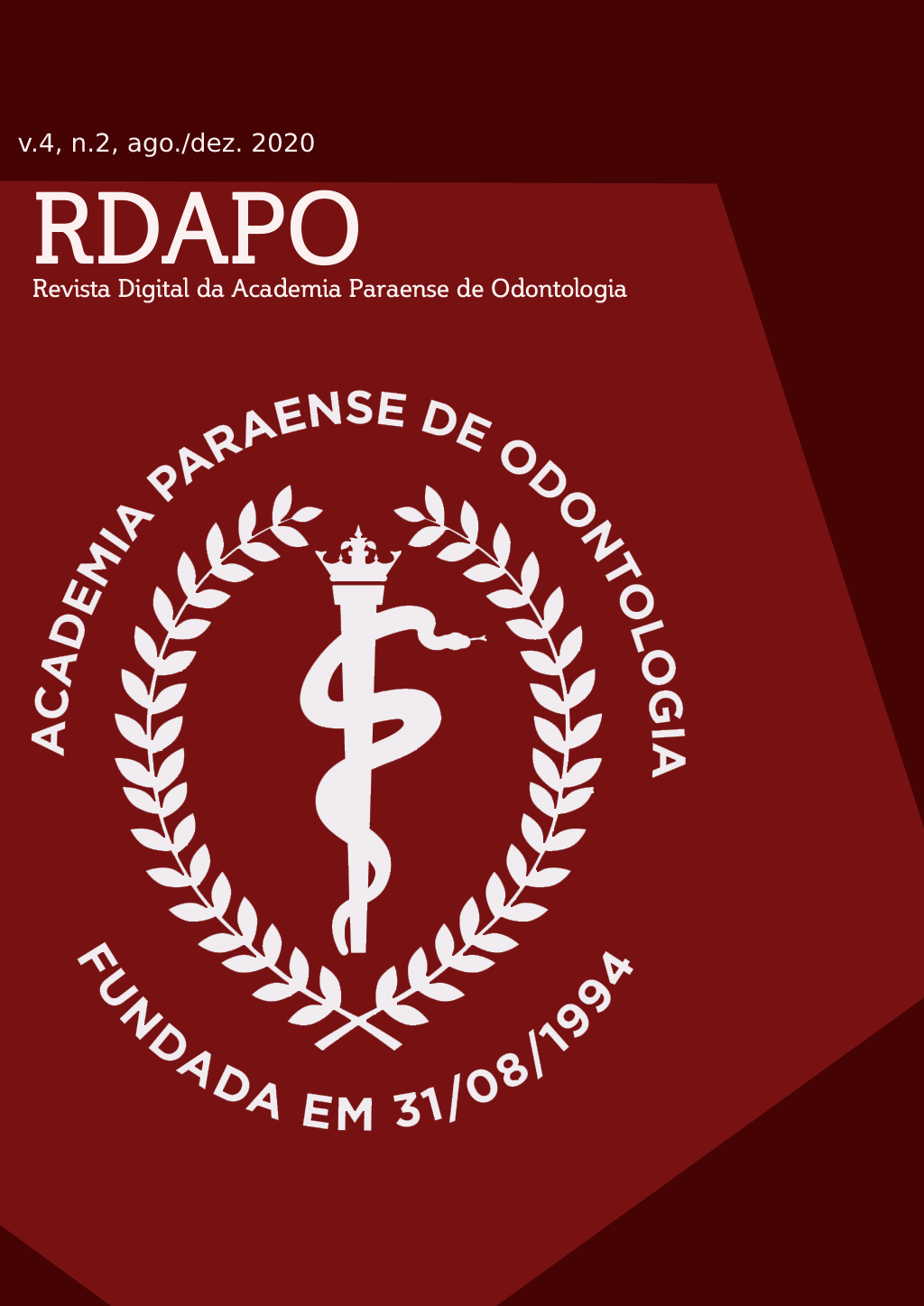Abstract
Introduction: Ozone (O3) is a natural gas and a potent and selective oxidizer and when it comes into contact with tissues it quickly dissociates, releasing reactive forms of oxygen that can oxidize cells, having possible and favorable antimicrobial efficacy and can be used as a source Complement of disinfection in the chemomechanical preparation of root canals. Objective: to report the use of ozone therapy as a complementary therapy in the treatment of extensive periapical lesions. Case report: Female patient, 34 years old, non-smoker and without systemic alterations, sought the dental clinic of a college in northern Brazil with the main complaint of dental pain (toothache) and presenting edema and swelling in the antero-inferior region. The intraoral clinical examination showed the presence of a point of drainage of purulent exudate via the periapical route, chromatic change in elements 31 and 41, grade 1 mobility, absence of loss of the clinical attachment level, drainage of purulent exudate and bleeding via the gingival sulcus, as well. as the absence of biofilm or supra/subgingival calculi and the tomographic exam showed the presence of extensive periapical lesion in teeth 32, 31, 41 and 42. The endodontic treatment was performed by the crown-down technique using ozone therapy associated with surgery paraendodontic with bone graft with xenogenic material. Conclusion: After forty days, it was identified absence of mobility of the involved teeth and disappearance of edema and drainage point, in the radiographic examination there was a significant reduction of the lesion, demonstrating that the association between ozone therapy and standard mechanical endodontic treatment resulted in satisfactory clinical success.
References
Nogales CG, Ferrari PH, Kantorovich EO, Lage-Marques JL. Ozone therapy in medicine and dentistry. J Contemp Dent Pract. 2008, 1; 9(4):75-84.
Nardello LCL, Amado PPP, Franco DC, Cazares RXR, Nogales CG, Mayer MPA, et al. Next-Generation Sequencing to assess potentially active bacteria in endodontic infections. J Endod. 2020, 46(8):1105-1112.
Gupta G, Mansi B. Ozone therapy in periodontics. J Med Life. 2012, 22; 5(1):59-67.
Domb WC. Ozone therapy in dentistry. A brief review for physicians. Interv Neuroradiol. 2014, 20(5):632-6.
Re L, Rowen R, Travagli V. Ozone therapy and its use in medicine. Cardiology. 2016, 134(2):99-100.
Andreula C. Ozone therapy. Neuroradiology. 2011, 53 Suppl 1:S207-9.
Grupo Philozon (Philozon). Sobre o ozônio [Internet]. 2021. Available in: https://www.philozon.com.br/sobre-o-ozonio/. (Accessed in 16 March 2021).
Deepthi R, Bilichodmath S. Ozone therapy in periodontics: a meta-analysis. Contemp Clin Dent. 2020, 11(2):108-115.
Tasdemir Z, Oskaybas MN, Alkan AB, Cakmak O. The effects of ozone therapy on periodontal therapy: A randomized placebo-controlled clinical trial. Oral Dis. 2019, 25(4):1195-1202.
Silva EJNL, Prado MC, Soares DN, Hecksher F, Martins JNR, Fidalgo TKS. The effect of ozone therapy in root canal disinfection: a systematic review. Int Endod J. 2020, 53(3):317-332.
Borges GÁ, Elias ST, da Silva SM, Magalhães PO, Macedo SB, Ribeiro AP, et al. In vitro evaluation of wound healing and antimicrobial potential of ozone therapy. J Craniomaxillofac Surg. 2017, 5(3):364-370.
Chubb DWR. A review of the prognostic value of irrigation on root canal treatment success. Aust Endod J. 2019, 45(1):5-11.
Plotino G, Cortese T, Grande NM, Leonardi DP, Di Giorgio G, Testarelli L, et al. New technologies to improve root canal disinfection. Braz Dent J. 2016, 27(1):3-8.
Gołąbek H, Borys KM, Kohli MR, Brus-Sawczuk K, Strużycka I. Chemical aspect of sodium hypochlorite activation in obtaining favorable outcomes of endodontic treatment: An in-vitro study. Adv Clin Exp Med. 2019, 28(10):1311-1319.
Prada I, Micó-Muñoz P, Giner-Lluesma T, Micó-Martínez P, Muwaquet-Rodríguez S, Albero-Monteagudo A. Update of the therapeutic planning of irrigation and intracanal medication in root canal treatment. A literature review. J Clin Exp Dent. 2019, 1; 11(2):e185-e193.
Bergenholtz G. Assessment of treatment failure in endodontic therapy. J Oral Rehabil. 2016, 43(10):753-8.
Prada I, Micó-Muñoz P, Giner-Lluesma T, Micó-Martínez P, Collado-Castellano N, Manzano-Saiz A. Influence of microbiology on endodontic failure. Literature review. Med Oral Patol Oral Cir Bucal. 2019, 1;24(3):e364-e372.
Santos-Junior AO, De Castro Pinto L, Mateo-Castillo JF, Pinheiro CR. Success or failure of endodontic treatments: A retrospective study. J Conserv Dent. 2019, 22(2):129-132.
Alghamdi F, Shakir M. The Influence of enterococcus faecalis as a dental root canal pathogen on endodontic treatment: a systematic review. Cureus. 2020, 13; 12(3):e7257.
Alghamdi F, Alhaddad AJ, Abuzinadah S. Healing of periapical lesions after surgical endodontic retreatment: a systematic review. Cureus. 2020, 7; 12(2):e6916.
Diário Oficial da União. Resolução No 166 [Internet]. 2015. Available in: https://pesquisa.in.gov.br/imprensa/jsp/visualiza/index.jsp?jornal=1&pagina=95&data=08/12/2015. (Accessed in 26 March 2021).
LegisWeb. Resolução CFO Nº 166 de 24/11/2015 [Internet]. 2015. Available in: https://www.legisweb.com.br/legislacao/?id=313364. (Accessed in 26 March 2021).
Deepthi R, Bilichodmath S. Ozone therapy in periodontics: a meta-analysis. Contemp Clin Dent. 2020, 11(2):108-115.
Suh Y, Patel S, Kaitlyn R, Gandhi J, Joshi G, Smith NL, et al. Clinical utility of ozone therapy in dental and oral medicine. Med Gas Res. 2019, 9(3):163-167.
Nogales CG, Ferreira MB, Montemor AF, Rodrigues MFA, Lage-Marques JL, Antoniazzi JH. Ozone therapy as an adjuvant for endondontic protocols: microbiological – ex vivo study and citotoxicity analyses. J. Appl. Oral Sci. 2016, 24(6):607-13.
Huth KC, Quirling M, Maier S, Kamereck K, Alkhayer M, Paschos E, et al. Effectiveness of ozone against endodontopathogenic microorganisms in a root canal biofilm model. Int Endod J. 2009, 42(1):3-13.
Hubbezoglu I, Zan R, Tunc T, Sumer Z. Antibacterial efficacy of aqueous ozone in root canals infected by enterococcus faecalis. Jundishapur J Microbiol. 2014, 7(7):e11411.
Vasavada K, Kapoor S. Evaluation of ozonized calcium hydroxide as an effective intracanal medicament during root canal procedures: an in vitro observational study. Med Gas Res. 2020, 10(3):122-124.
Noites R, Pina-Vaz C, Rocha R, Carvalho MF, Gonçalves A, Pina-Vaz I. Synergistic antimicrobial action of chlorhexidine and ozone in endodontic treatment. Biomed Res Int. 2014: 592423.
Kist S, Kollmuss M, Jung J, Schubert S, Hickel R, Huth KC. Comparison of ozone gas and sodium hypochlorite/chlorhexidine two-visit disinfection protocols in treating apical periodontitis: a randomized controlled clinical trial. Clin Oral Investig. 2017, 21(4):995-1005.

This work is licensed under a Creative Commons Attribution 4.0 International License.
Copyright (c) 2020 RDAPO

